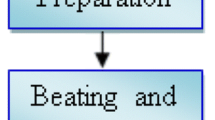Abstract
The development of a curcumin-based sensor for the detection of volatile amines (specifically known as total volatile basic nitrogen, TVBN) is described. Curcumin [(1E,6E)-1,7-bis(4-hydroxy-3-methoxyphenyl)hepta-1,6-diene-3,5dione] is the major yellow pigment extracted from turmeric, a commonly used spice, derived from the rhizome of the plant Curcuma longa. Curcumin was immobilized onto bacterial cellulose membrane via the absorption method. Thus, the sensing materials are edible and suitable for food applications. The curcumin/bacterial cellulose membrane as the TVBN sensor worked based on pH increase as the basic spoilage volatile amines produced gradually in the package headspace, and subsequently, the color of the sensor will change from yellow to orange, then to reddish orange for spoilage indication, which is easily visible to the naked eye. The curcumin membrane is a highly sensitive material toward acid–base reactions. Color changes, as a result of its interactions with increasing pH (as a result of increasing TVBN), were monitored directly with visual inspection and the color quantitatively measured with color analysis via Photoshop software. Furthermore, the membrane response was found to correlate with bacterial growth patterns in shrimp samples. Finally, the curcumin/bacterial cellulose membrane was successfully used as a sticker sensor for real-time monitoring of shrimp spoilage in ambient and chiller conditions.









Similar content being viewed by others
References
Badan Standardisasi Nasional (2006) Standar Nasional Idonesia (SNI) no. 01-2729.1-2006, Mutu Ikan Segar, Jakarta
Bene A, Hayman A, Reynard E, Luisier JL, Villettaz JC (2001) A new method for the rapid determination of volatile substances: the SPME-direct method—Part II. Determination of the freshness of fish. Sens Actuators B 72:204
Byrne L, Lau KT, Diamond D (2002) Monitoring of headspace total volatile basic nitrogen from selected fish species using reflectance spectroscopic measurements of pH sensitive films. Analyst 127:1338
Chattopadhyay I, Biswas K, Bandyopadhyay U, Banerjee RK (2004) Turmeric and curcumin: biological actions and medicinal applications. Current Sci 87:44
Ciechańska D, Struszczyk H, Gruzińska K (1998) Modification of bacterial cellulose. Fibres & Textiles in Eastern Europe 6:61
Commission Decision 95/149/EC of 8 March (1995) fixing the total volatile basic nitrogen (TVB-N) limit values for certain categories of fishery products and specifying the analysis methods to be used. Official Journal, L 097:84
Connell JJ (1995) Control of fish quality, 4th edn. Fishing News Books, Farnham Surrey, p 157
Elliot RP (1952) Reduction of trimethylamine oxide in dogfish flesh. Food Res 17:225
Francis FJ (1994) Colorimetric properties of foods. In: Rao MA, Rizvi SSH (eds) Engineering properties of foods, 2nd edn. Marcel Dekker, New York, pp 495–523
Gunasekaran S (1996) Computer vision technology for food quality assurance. Trends Food Sci Technol 7:245
Hamada-Sato N, Kazushige U, Kobayashi T, Imada C, Watanabe E (2005) Quality assurance of raw fish based on HACCP. Food Con 16:301
Howgate P, Johnson A, Whittle KJ (1992) Multilingual guide to EC freshness grades for fishery products. F.S.D. Research Station, Ministry of Agriculture, Fisheries and Food, Aberdeen, Scotland
Hunt RWG (1991) Measuring colour, 2nd edn. Ellis Horwood, New York
Huss HH (1995) Quality and quality changes in fresh fish. FAO, Fisheries Technical Paper 348. Rome, p 195
Iguchi M, Yamanaka S, Budhino A (2000) Review. Bacterial cellulose—a masterpiece of nature’s art. J Mater Sci 35:261
Koutsoumanis K (2001) Predictive modeling of the shelf life of fish under non-isothermal conditions. Applied Environ Microb 67:1821
Kyrana VR, Lougovois VP (2002) Sensory, chemical and microbiological assessment of farm-raised European sea bass (Dicentrarchus labrax) stored in melting ice. Int J Food Sci Tech 37:319
Olafsdottir G, Kristbergsson K (2006) In: Nicolay X (ed) Odors in the food industry. Springer, New York, p 57
Olafsdottir G, Martinsdottir E, Oehlenschlager J, Dalgaard P, Jensen B, Undeland I, Mackie IM, Henehan G, Nielsen J, Nilsen H (1997) Methods to evaluate fish freshness in research and industry. Trends Food Sci Technol 8:258
Olafsdottir G, Nesvadba P, Di Natale C, Careche M, Oehlenschlager J, Tryggvadóttir SV, Schubring R, Kroeger M, Heia K, Esaiassen M, Macagnano A, Jørgensen Bo M (2004) Multisensor for fish quality determination. Trends Food Sci Technol 15:86
Pacquit A, Lau KT, McLaughlin H, Frisby J, Quilty B, Diamond D (2006) Development of a volatile amine sensor for the monitoring of fish spoilage. Talanta 69:515
Pacquit A, Frisby J, Diamond D, Lau KT, Farrell A, Quilty B, Diamond D (2007) Development of a smart packaging for the monitoring of fish spoilage. Food Chem 102:466
Ruiz-Capillas C, Gillyon CM, Horner WFA (2000) Determination of volatile basic nitrogen and trimethylamine nitrogen in fish sauce by flow injection analysis. Eur Food Res Technol 210:434
Surma-Ślusarska B, Presler S, Danielewicz D (2008) Characteristics of bacterial cellulose obtained from Acetobacter xylinum culture for application in papermaking. Fibres &Textiles in Eastern Europe 16:108
Yam KL, Papadakis SE (2004) A simple digital imaging method for measuring and analyzing color of food surfaces. J Food Eng 61:137
Acknowledgment
The authors gratefully thank the DP2M, Higher Education, Ministry of National Education, Republic of Indonesia, for supporting this work via the International Research Collaboration Program 2010 (Penelitian Kerjasama Luar Negeri dan Publikasi Internasional no. 438/SP2H/PP/DP2M/III/2010).
Author information
Authors and Affiliations
Corresponding author
Rights and permissions
About this article
Cite this article
Kuswandi, B., Jayus, Larasati, T.S. et al. Real-Time Monitoring of Shrimp Spoilage Using On-Package Sticker Sensor Based on Natural Dye of Curcumin. Food Anal. Methods 5, 881–889 (2012). https://doi.org/10.1007/s12161-011-9326-x
Received:
Accepted:
Published:
Issue Date:
DOI: https://doi.org/10.1007/s12161-011-9326-x




